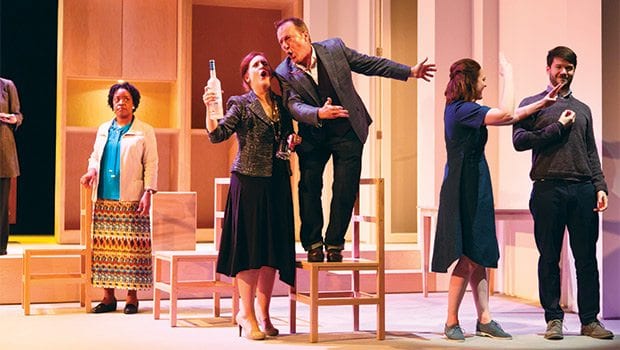Lost in translation
Huntington’s ‘I Was Most Alive With You’ wins with ASL, struggles with plot

Murphy’s Law is in full effect during the Huntington Theatre’s production of “I Was Most Alive With You,” playing through June 26. The story centers on Knox (Russell Harvard), who is a deaf, gay, recovering addict with a newly-found interest in spirituality. It turns out his disabilities are the least of his problems.
The show must be lauded for its inclusion of and focus on the deaf community. Performed in both English and ASL, each actor has a shadow interpreter who signs for their character. The interpreters aren’t just there for translation; they are actors performing in tandem with their English-speaking counterparts. In some cases they come off as silent but powerful incarnations of the characters’ souls. Harvard, who is a deaf actor himself, stands alone, without an interpreter, for most of the show, an indication of his isolation from the rest of the cast.
The plot is a bit less elegant than the use of language. Hardship and trial are essential to any good story, but “I Was Most Alive With You” has more tragic plot twists than 54 seasons of General Hospital. Interwoven between the cancer diagnosis, the casual mention of domestic abuse, the jail time, the drug overdoses, the theft, the abandonment, the mutilation and the ever-present threat of suicide are heavy-handed spiritual discussions and passages from Job. The connection between the embattled biblical figure and Knox’s struggling family is clear, but perhaps not necessary in an already complicated script.
Despite the weighty content, the show is aesthetically stunning. Lighting, blocking and set design come together for a visually powerful portrayal of loneliness and struggle. At the end of the first act, Knox’s mother Pleasant (Dee Nelson) receives a phone call from his boyfriend Farhad (Tad Cooley) with some catastrophic news. The two characters stand next to each other on the dark stage, with dim lighting illuminating Pleasant in her bathrobe and Farhad in a frantic state of distress. He yells into the phone while she struggles to understand what happened. The music and conversation abruptly stop as the characters internalize the importance of the news. “Bam,” they say and the stage goes dark.
The actors too, must be commended for a commanding execution of a difficult script. Dee Nelson as Pleasant and Amelia Hensley as Pleasant’s ASL shadow embody a woman who is dedicated to her family, but consistently made to feel inadequate. She uses humor and alcohol to patch her wounds but ultimately it’s not enough to replace the love she craves. Harvard shone as the fragile Knox who oscillates from spiritual, and positive, to an addiction-riddled loner. Pleasant and Farhad bring some much-needed humor to the first act, although that essential comic relief is missing from the dense second act.
“I Was Most Alive With You” is not an easy show to watch. From a plot perspective it could have used substantial editing. Yet despite its problems, it represents a powerful step for the deaf community in Boston. Not only is the show itself accessible to and written for a deaf audience, it proves that a handicap doesn’t define the person who lives with it.




![Banner [Virtual] Art Gallery](https://baystatebanner.com/wp-content/uploads/2024/04/NJ-H_1-713x848.jpg)

